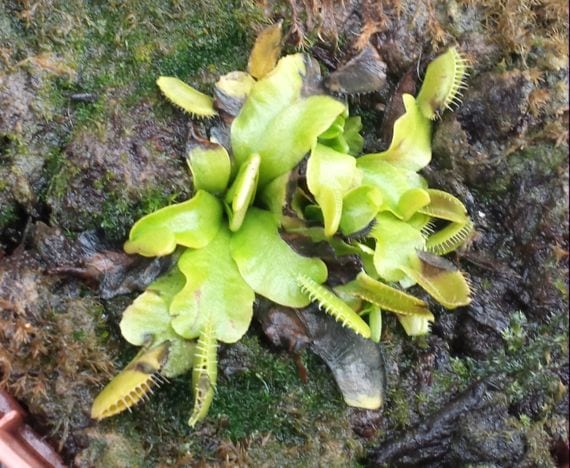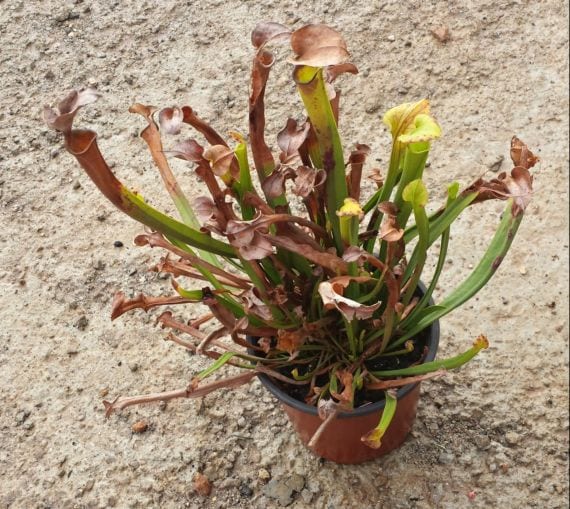
With the arrival of the cold our carnivorous they begin to slow down more and more the growth rate, to take out smaller and smaller leaves, and / or to lose said leaves. They have entered a state of hibernation.
The duration of this state depends on the climate we have. It will be longer if it is colder, or shorter if it is warmer. Generally, it should last a few three months.
Most carnivorous plants are of tropical or subtropical origin. Some, like the Venus flytrap (top photo) or the Sarracenia (bottom photo) can withstand very weak and very short-lived frosts.

If we live in a climate with frosts down to -3º, we can have our plants outside, allowing them to hibernate naturally. Otherwise, we must protect them in greenhouses, terrariums or indoors until the risk of frost has passed.
Outdoor plants: natural hibernation
From spring to late autumn, the growth rate is normal. They take leaves, they hunt, they even bloom. But, with the arrival of the cold, we see that they grow more slowly, some traps begin to dry up, smaller and smaller leaves sprout, ... It will be time to start spreading the risks. If we have a plate or tray under them, I advise removing it on the days when there is a forecast of rain, since the roots could rot and we could lose the plant.
It is highly recommended to remove the dry leaves to avoid the proliferation of fungi.
Indoor plants: artificial hibernation
If we live in a hot or very cold climate, we will have no choice but to create a winter for our carnivores in the first case or by protecting them at home in the second.
How do I create a winter if there isn't any where I live?
In the case of the Venus flytrap, proceed as follows:
- The plant is removed from the pot.
- The brown peat or moss is carefully removed.
- It is wrapped with a damp paper (distilled water, rain or reverse osmosis).
- It is sprayed with fungicide, with half the recommended dose.
- It is introduced into a tupperware.
- And finally we put it in the fridge, where it will be for three months at about 5 degrees.
All other carnivorous plants can adapt to the hot climate. In fact, very few species live in cold climates. If the temperature in our area is always above ten degrees, it will be advisable to choose species adapted to living in a tropical climate, such as Drosera omissa, Nephentes attenboroughii, etc.
How do I protect my plants from the harsh winter?
If the frosts are very intense in our area, we will have no choice but to keep them indoors. We can put them in five-liter bottles, cutting the container in half, and later use the upper half as a lid, gluing it with tape for example. Thus, we can place it near a radiator without running the risk that the air currents are harmful.
Consequences of non-hibernation
In reality, the symptoms of little or no hibernation can be similar to when we do not sleep or do not get enough sleep. Indeed, dark circles, fatigue, ... we do not perform at our best. The same thing happens to carnivores that need to hibernate, that is, do not grow properly, they have to do a double effort to remove a leaf, ... therefore, it will not take long to see her very decayed, we may even lose her.
This is why if you have especially Sarracenias and Dioneas, it is very important that they hibernate, that they spend a little cold for three months.
More information - Caring for carnivorous plants
I am not very clear if the Saracenea should hibernate too?
Hi Valdine.
Yes, Sarracenia need a bit of cold during the winter so that they can develop properly later. If in your area the temperature drops to -4º Celsius you can have it outside. On the other hand, if it goes lower, you have to protect it in a greenhouse or even indoors (inside a very bright room).
Greetings, and if you have any doubts, here we are 🙂
Sarracenias, Dionaeas and some sundews such as nordicas, Mexican pinguiculas and others hibernate, during hibernation it is advisable to reduce irrigation to simple humidity in the substrate and remove the irrigation trays since it is easier for them to die from rot. or they are forced to wake up, fooling the plants into believing that it is spring already by looking for a warmer and more humid place, some sarracenia hibernate up to 6 months, some pinguiculas 8 months so each species must be investigated well before acquiring it or as soon as it is acquired, it should be remembered that both Dionaea and Sarracenias are plants as suitable for the interior as a rose bush or a dahlia, this means that if they do not feel the changes in light and temperatures between day and night or the differences between the 4 seasons of the year the plants will be exhausted and will die as soon as a person who travels daily from China to Mexico during the night to arrive by day or Someone who is awake 24 hours a day.
To summarize, before acquiring a carnivorous or non-carnivorous plant it is advisable to analyze the type of climate where you live, compare it with the type of climate of your plant to acquire, place the data on a scale and compare to see how easily you can reproduce a microclimate similar to its natural habitat and how expensive it will be to maintain that microclimate (in my case in Querétaro, dionaeas, sarracenias, highland nepenthes, pinguiculas, nordic sundews, tuberous sundews in the open air and I battle a lot with lowland nepenthes that many are very easy plants to care for the type of climate I have) greetings!
Any questions you can find me on Twitter with my name from the comment :) I hope I have been helpful
It is true: before acquiring a plant it is very important to know whether or not it will be able to live in our climate, otherwise we will have to give it extra care and that means that more money will have to be spent on substrates, fertilizers and insecticides. It can be made clear, but if you do not have much experience caring for plants, or if you simply do not want to complicate yourself, it is best to acquire native plants, or that resist the climate that is in your area.
Hello good night, I have a day I live in a very hot climate, now it is in hibernation but the climate is still very hot. What can you recommend?
Hi Karina.
If the temperature is high, I advise you to treat the Dioneas with chemical fungicide and put them in a transparent plastic bag with a hermetic seal, in the fridge.
After two months, they can be removed and they will resume growth.
A greeting.
Good night. I have a question. I just bought a Venus flytrap, when I bought it they told me it was only half a year old. The thing is that it is presenting symptoms of hibernation and I live in a very warm place so it needs artificial hibernation, I would like to know if I already have to hibernate it, even if it is only half a year old
Hola!
Yeah sure. But when you say 'warm weather', what temperatures are we talking about? I ask you because where I live for example, the minimum temperature is -1ºC, there are always occasional frosts and of very short duration, and the Venus flytrap hibernates without problems.
In the event that there is never frost in your area, you should put it in the fridge for a couple of months, checking once a week that no fungus appears. For this, it is highly recommended to treat it before with copper or powdered sulfur.
If you have any questions, consult 🙂
Greetings.
Hello, I have a Venus flytrap, I have it under a window and I live in Querétaro too, do you think I should do something to make it go into hibernation or is it okay to leave it there?
Hello Esteban.
If the temperature in your area reaches 0 degrees or even if there is a weak frost (-1, or -2 degrees Celsius) you can leave it out all year round.
Greetings.
Hello, I recently bought a Dionaea and it is almost winter season, but where I live, which is Querétaro, there are not low temperatures (0, -1, -2), the average minimum is 6 degrees, and I would like to know if the The plant will give me indications that it is hibernating or because of the temperature it will not and I will have to "force" it, I am taking into account that in either case I will have to make it hibernate artificially, but as I said, I want to know if it " it will warn "or I will have to do it" forced "(putting it directly into the refrigerator).
Hello Jorge.
Well, in those situations you may notice that it grows more slowly, or that it even takes out smaller leaves / traps.
Anyway, if there is no change in its behavior, as soon as winter comes, put it in the refrigerator 😉
Greetings.
Hello Mónica Sánchez, I have the Venus Flytrap, I live in Mexico City, my doubt is that if the climate is appropriate for the plant, they gave it to me in a plastic box, my doubt is that if I put it in the refrigerator with the plastic box or alone .
Thanks and regards
Hello Sofia.
If in your area there is a frost of up to -2ºC you can leave it outside all year; otherwise you have to remove it from the pot, treat its roots with a little copper or sulfur to avoid infections, and then wrap them with kitchen paper, and all in an open transparent plastic bag.
Greetings.